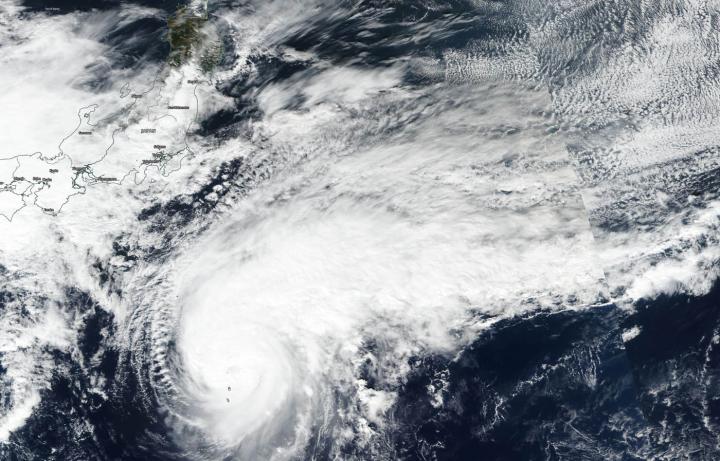
Credit: NASA Worldview, Earth Observing System Data and Information System (EOSDIS)
NASA-NOAA’s Suomi NPP satellite passed over the Northwestern Pacific Ocean revealed that Typhoon Bualoi continued to look asymmetric because of ongoing wind shear. The Joint Typhoon Warning Center issued the final bulletin on Bualoi as it was beginning the transition into an extra-tropical cyclone.
On Oct. 25, the Visible Infrared Imaging Radiometer Suite (VIIRS) instrument aboard NASA-NOAA’s Suomi NPP satellite captured a visible image of the structure of Bualoi. The storm appeared elongated from southwest to northeast, indicating that it had begun its transition into an extra-tropical cyclone. The image was generated by NASA Worldview, Earth Observing System Data and Information System (EOSDIS), at NASA’s Goddard Space Flight Center in Greenbelt, Md.
What Wind Shear Does to a Tropical Cyclone
In general, wind shear is a measure of how the speed and direction of winds change with altitude. Tropical cyclones are like rotating cylinders of winds. Each level needs to be stacked on top each other vertically in order for the storm to maintain strength or intensify. Wind shear occurs when winds at different levels of the atmosphere push against the rotating cylinder of winds, weakening the rotation by pushing it apart at different levels.
What does Extra-tropical Mean?
When a storm becomes extra-tropical it means that a tropical cyclone has lost its “tropical” characteristics. The National Hurricane Center defines “extra-tropical” as a transition that implies both poleward displacement (meaning it moves toward the north or south pole) of the cyclone and the conversion of the cyclone’s primary energy source from the release of latent heat of condensation to baroclinic (the temperature contrast between warm and cold air masses) processes. It is important to note that cyclones can become extratropical and still retain winds of hurricane or tropical storm force.
Bualoi’s Final Advisory
When the Joint Typhoon Warning Center issued their final bulletin on Bualoi at 5 a.m. EDT (0900 UTC), the storm was centered near latitude 33.7 degrees north and longitude 148.0 degrees east, about 421 nautical miles east of Yokosuka, Japan. The storm was speeding to the northeast at 25 knots (28 mph/44 kph) and had maximum sustained winds near 65 knots (75 mph/120 kph).
Forecasters at the Joint Typhoon Warning Center said that Bualoi was moving north-northeast and will continue to weaken. The storm is forecast to make its transition to an extra-tropical cyclone well to the east of Japan by the end of the day on Oct. 25.
###
Hurricanes are the most powerful weather event on Earth. NASA’s expertise in space and scientific exploration contributes to essential services provided to the American people by other federal agencies, such as hurricane weather forecasting.
By Rob Gutro
NASA’s Goddard Space Flight Center
Media Contact
Rob Gutro
[email protected]
Original Source
https:/




